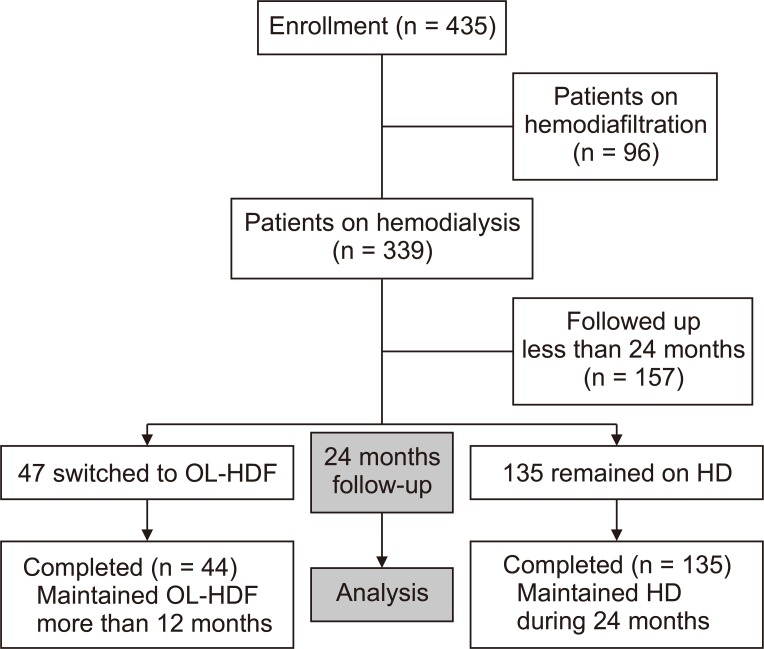1. Chan CT, Blankestijn PJ, Dember LM, et al. Conference Participants. 2019;Dialysis initiation, modality choice, access, and prescription: conclusions from a kidney disease: Improving Global Outcomes (KDIGO) Controversies Conference.
Kidney Int 96:37–47.

2. Thomas B, Wulf S, Bikbov B, et al. 2015;Maintenance dialysis throughout the world in years 1990 and 2010.
J Am Soc Nephrol 26:2621–2633.



3. Prasad N, Jha V. 2015;Hemodialysis in Asia.
Kidney Dis (Basel) 1:165–177.



4. Liyanage T, Ninomiya T, Jha V, et al. 2015;Worldwide access to treatment for end-stage kidney disease: a systematic review.
Lancet 385:1975–1982.


5. Nakai S, Iseki K, Tabei K, et al. 2001;Outcomes of hemodiafiltration based on Japanese dialysis patient registry.
Am J Kidney Dis 38(4 Suppl 1):S212–S216.


6. Maduell F, Moreso F, Pons M, et al. ESHOL Study Group. 2013;High-efficiency postdilution online hemodiafiltration reduces all-cause mortality in hemodialysis patients.
J Am Soc Nephrol 24:487–497.



7. Ağbaş A, Canpolat N, Çalışkan S, et al. 2018;Hemodiafiltration is associated with reduced inflammation, oxidative stress and improved endothelial risk profile compared to high-flux hemodialysis in children.
PLoS One 13:e0198320.



8. Suwabe T, Barrera-Flores FJ, Rodriguez-Gutierrez R, Ubara Y, Takaichi K. 2018;Effect of online hemodiafiltration compared with hemodialysis on quality of life in patients with ESRD: a systematic review and meta-analysis of randomized trials.
PLoS One 13:e0198320.



9. Canaud B, Bragg-Gresham JL, Marshall MR, et al. 2006;Mortality risk for patients receiving hemodiafiltration versus hemodialysis: European results from the DOPPS.
Kidney Int 69:2087–2093.


10. Vilar E, Fry AC, Wellsted D, Tattersall JE, Greenwood RN, Farrington K. 2009;Long-term outcomes in online hemodiafiltration and high-flux hemodialysis: a comparative analysis.
Clin J Am Soc Nephrol 4:1944–1953.



11. Locatelli F, Karaboyas A, Pisoni RL, et al. 2018;Mortality risk in patients on hemodiafiltration versus hemodialysis: a ‘real-world’ comparison from the DOPPS.
Nephrol Dial Transplant 33:683–689.


12. Morena M, Jaussent A, Chalabi L, et al. FRENCHIE Study Investigators. 2017;Treatment tolerance and patient-reported outcomes favor online hemodiafiltration compared to high-flux hemodialysis in the elderly.
Kidney Int 91:1495–1509.


13. Lee HS, Ju YS, Song YR, et al. 2018;Current treatment status and medical costs for hemodialysis vascular access based on analysis of the Korean Health Insurance Database.
Korean J Intern Med 33:1160–1168.



14. Macdougall IC, White C, Anker SD, et al. PIVOTAL Investigators and Committees. 2019;Intravenous iron in patients undergoing maintenance hemodialysis.
N Engl J Med 380:447–458.


15. Lippi A, Rindi P, Baronti R, et al. 1995;Recombinant human erythropoietin and high flux haemodiafiltration.
Nephrol Dial Transplant 10(Suppl 6):51–54.

16. Ward RA, Schmidt B, Hullin J, Hillebrand GF, Samtleben W. 2000;A comparison of on-line hemodiafiltration and high-flux hemodialysis: a prospective clinical study.
J Am Soc Nephrol 11:2344–2350.


17. Hamzagic N, Andjelkovic M, Pirkovic MS, Canovic P, Zaric M, Petrovic D. 2019 Jan 10 Influence of dialysis modality on the treatment of anemia in patients with end-stage kidney disease.
Ser J Exp Clin Res [Epub]. DOI: 10.2478/sjecr-2018-0050.

18. Bonforte G, Grillo P, Zerbi S, Surian M. 2002;Improvement of anemia in hemodialysis patients treated by hemodiafiltration with high-volume on-line-prepared substitution fluid.
Blood Purif 20:357–363.


19. Pedrini LA, De Cristofaro V, Comelli M, et al. 2011;Long-term effects of high-efficiency on-line haemodiafiltration on uraemic toxicity. A multicentre prospective randomized study.
Nephrol Dial Transplant 26:2617–2624.


20. Bowry SK, Gatti E. 2011;Impact of hemodialysis therapy on anemia of chronic kidney disease: the potential mechanisms.
Blood Purif 32:210–219.


21. Vega A, Quiroga B, Abad S, et al. 2015;Albumin leakage in online hemodiafiltration, more convective transport, more losses?
Ther Apher Dial 19:267–271.


22. Orasan RA, Patiu IM, Anghel D, et al. 2013;Variation of clinical and laboratory features in chronic dialysis patients treated with high-flux hemodialysis after switching to online hemodiafiltration.
Int Urol Nephrol 45:1415–1422.


23. Jean G, Hurot JM, Deleaval P, Mayor B, Lorriaux C. 2015;Online-haemodiafiltration vs. conventional haemodialysis: a cross-over study.
BMC Nephrol 16:70



24. Kubrusly M, Oliveira CM, Santos DC, Mota RS, Pereira ML. 2012;A comparative analysis of pre- and post-dialysis albumin as indicators of nutritional and morbi-mortality risks in haemodialysis patients.
J Bras Nefrol 34:27–35.


25. Kaysen GA, Don BR. 2003;Factors that affect albumin concentration in dialysis patients and their relationship to vascular disease.
Kidney Int Suppl (84):S94–S97.

26. Lukowsky LR, Kheifets L, Arah OA, Nissenson AR, Kalantar-Zadeh K. 2014;Nutritional predictors of early mortality in incident hemodialysis patients.
Int Urol Nephrol 46:129–140.


27. Fein PA, Weiss S, Avram MM, et al. 2015;Relationship of normalized protein catabolic rate with nutrition status and long-term survival in peritoneal dialysis patients.
Adv Perit Dial 31:45–48.

28. Kanda E, Kato A, Masakane I, Kanno Y. 2019;A new nutritional risk index for predicting mortality in hemodialysis patients: Nationwide cohort study.
PLoS One 14:e0214524.



29. Davenport A, Gardner C, Delaney M. Pan Thames Renal Audit Group. 2010;The effect of dialysis modality on phosphate control : haemodialysis compared to haemodiafiltration. The Pan Thames Renal Audit.
Nephrol Dial Transplant 25:897–901.


30. Lornoy W, De Meester J, Becaus I, Billiouw JM, Van Malderen PA, Van Pottelberge M. 2006;Impact of convective flow on phosphorus removal in maintenance hemodialysis patients.
J Ren Nutr 16:47–53.


31. Okuno S, Ishimura E, Kohno K, et al. 2009;Serum beta2-microglobulin level is a significant predictor of mortality in maintenance haemodialysis patients.
Nephrol Dial Transplant 24:571–577.


32. Ok E, Asci G, Toz H, et al. Turkish Online Haemodiafiltration Study. 2013;Mortality and cardiovascular events in online haemodiafiltration (OL-HDF) compared with high-flux dialysis: results from the Turkish OL-HDF Study.
Nephrol Dial Transplant 28:192–202.


33. National Kidney Foundation. 2003;K/DOQI clinical practice guidelines for bone metabolism and disease in chronic kidney disease.
Am J Kidney Dis 42(4 Suppl 3):S1–S201.

34. Jin DC. 2011;Current status of dialysis therapy in Korea.
Korean J Intern Med 26:123–131.



35. Jin DC, Yun SR, Lee SW, et al. 2018;Current characteristics of dialysis therapy in Korea: 2016 registry data focusing on diabetic patients.
Kidney Res Clin Pract 37:20–29.



36. Kim YW, Park S. 2016;Confronting practical problems for initiation of on-line hemodiafiltration therapy.
Electrolyte Blood Press 14:1–4.









 PDF Links
PDF Links PubReader
PubReader Full text via DOI
Full text via DOI Download Citation
Download Citation Print
Print















